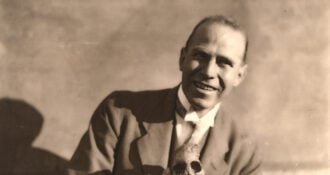In this never-before-released archival lecture from 1980, Maasai warrior, author, and Leakey Foundation grantee Tepilit Ole Saitoti discusses the Maasai culture and the challenges facing the Maasai in Kenya and Tanzania.
The Maasai are semi-nomadic pastoralist people who live in Kenya and Tanzania. It’s estimated that there are over one million Maasai living today.
They make their living by herding sheep, goats, and cows. They move with the seasons to graze their herds. Their culture is centered around cattle, and their cultural traditions reach back thousands of years.
In the early 1900s, soon after the British first colonized East Africa, the Maasai lost around 60% of their traditional lands in a series of treaties. In the decades after that, they lost more land as the Kenyan and Tanzanian governments established National Parks and wildlife preserves.
In this episode of our Origin Stories podcast – another in our From the Archive series – Tepilit Ole Saitoti tells his story and the story of his people.
Tepilit Ole Saitoti was born in Maasailand in Tanzania in 1949. His father had 36 children, and of those, Tepilit Ole Saitoti was the one who was chosen to go to school.
After graduating he returned home and became a warrior.
Later he worked as a ranger for the Serengeti National Park where he was discovered by a National Geographic film crew. In 1972, National Geographic made a documentary about Saitoti called “Man of the Serengeti.”
Saitioti later said he was dissatisfied by the stories other people were telling about the Maasai, and he decided he wanted to tell their story himself. He thought that education and storytelling were tools he could use to enable him to protect Maasai cultural traditions while helping his people to adapt.
So he earned a Bachelors degree in creative writing from Emerson College in Boston, and then with funding from The Leakey Foundation, he earned a master’s degree in natural resources and wildlife management from the University of Michigan.
In 1980, he wrote a book called Maasai with photographer Carol Beckwith, and he went on a Leakey Foundation speaking tour to share the story of his people. In 1988, he published an autobiography called The Worlds of a Maasai Warrior.

A flyer for a 1981 lecture by Tepilit Ole Saitoti at MiraCosta College. Note that this flyer says Saitoti’s father had 57 children. In his lecture he says his father had 36 children.
In this episode of Origin Stories, you’ll hear his Leakey Foundation lecture entitled “Maasai, the Land and People.” It was one of many lectures Saitoti gave on behalf of the Foundation during his lecture tours in the late 1970s and early 1980s.
In this talk, he tells some of his life story, and he describes the Maasai way of life – including what it’s like to be a Maasai warrior.
https://radiopublic.com/origin-stories-6VPVbG/ep/s1!51260
Want to learn more about Maasai cultural traditions? Here are some resources:
- Maasai Association website
- Maasai by Tepilit Ole Saitoti and Carol Beckwith
- The Worlds of a Maasai Warrior by Tepilit Ole Saitoti








Comments 0